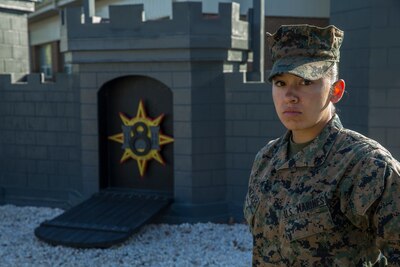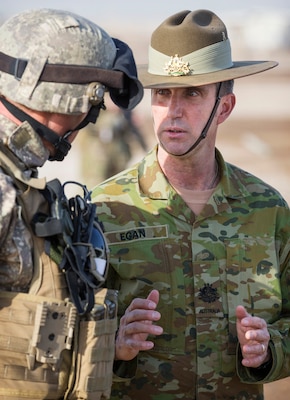By Jim Garamone DoD News, Defense Media Activity
SYDNEY, March 6, 2018 — Warrant Officer Class One Craig Egan
of the Australian Defense Force deals easily with American noncommissioned
officers -- they speak the same language, they go through many of the same
schools, and they belong to militaries that have the same philosophy on the use
of NCOs.
“That’s rare,” Egan said during an interview here. “Many
countries do not empower the contributions of NCOs, and they are missing a
significant opportunity to gain initiative and maintain agility on the
battlefield.”
Egan is the command warrant officer for Australia’s Joint Operations
Command based in Canberra -- meaning his appointment is the most-senior joint
enlisted position in the Australian military. He presents enlisted members’
perspectives to the chief of joint operations, who commands all Defense Force
personnel deployed on operations across the globe. He was in Australia’s
largest city to meet with U.S. Army Command Sgt. Maj. John W. Troxell, the
senior enlisted advisor to the chairman of the Joint Chiefs of Staff.
“The core belief of both militaries is that NCOs understand
commanders’ intent and act within their authority to accomplish their
missions,” Egan said.
It comes down to trust and education, he said. Australian
and American NCOs are the backbones of their respective services. They are
responsible to their commanders for the hands-on training and day-to-day
leadership that service members receive. At the foundation level, they are
responsible for enforcing standards and ensuring discipline. With increased
rank and responsibilities, they are the eyes and ears of commanders while
advocating enlisted perspectives and influencing early planning to assist
decision making.
And they are trusted to do their jobs.
Different From Other Militaries
This culture does not sit naturally in all militaries around
the world. In many military establishments, particularly the enlisted force
with a conscript background, NCOs are simply those farther along in their
terms. They are trained to act within a far more limited scope as determined by
their officers, and this has a direct influence on how they develop as leaders
in their own right.
In some other countries, enlisted personnel do not have the
education to be NCOs -- the educated in those countries become officers. This
structure may have some initial utility if a doctrine is based on ‘the massing
of troops,’ Egan said, but is vulnerable when dealing with the complexity of
the modern battlefield, which demands increasing levels of initiative in the
small teams typically led by NCOs.
History shows that NCOs in authoritarian states tend not to
be trusted to exercise initiative. After the fall of the Berlin Wall and the
dissolution of the Warsaw Pact, the countries of Eastern and Central Europe
reformed their militaries to emulate the enlisted forces of the United States,
the United Kingdom and Australia.
The United States and Australia have fought shoulder to
shoulder since World War I. Australian and U.S. service members fought through
some of the toughest campaigns of World War II and in Korea. Australian troops
fought alongside U.S. military members in Vietnam and Desert Storm, and they
have been part of ongoing operations in Afghanistan and Iraq.
And the two nations’ militaries have been and continue to be
interoperable. The difference between the two nations is more in scale than in
philosophy. “We’re a small, extremely capable and well-trained military. We can
stand beside our U.S. peers on equal status,” Egan said. “We’re proud, and with
humility, pretty good at what we do.”
The entire Australian military has about 58,200 active-duty
personnel, 40,000 reservists and 20,000 defense civilians. The United States
has a military establishment of around 3 million.
“It’s the sense of scale the United States brings, the
ability to project force and bring in all the enablers around an operation,”
Egan said.
Learning From Each Other
The Australian military has its own ways of doing things,
Egan said. It mirrors that country’s experiences in the region, in operations
outside the area and its military history. U.S. and Australian service members
learn from each other in military schools, in exercises and in actual
operations. “The levels of collaboration, cooperation and mateship are
exceptional,” Egan said.
Egan used the biennial Exercise Talisman Sabre as an example
where the two militaries learn from each other. “Talisman Sabre is a classic
example of the U.S. bringing a larger force and a larger dimensions,” he said.
The most-recent Talisman Sabre had 33,000 service members participating -- most
from the United States.
“We cannot replicate with the amount of troops the amount of
equipment, maritime platforms, the long-reach and the volume of [strategic]
airlift that the United States has got,” Egan said. “Flying troops all the way
from Alaska and parachuting them into the Shoalwater Bay Training Area --
that’s a phenomenal effort. That scale allows us to test our higher levels of
command, control, communications, planning and integration both practically and
synthetically.”
Egan’s story with Americans began in 1983 in Northern
Australia at the Jungle Training Center in Tully as part of Exercise Tropic
Lightning with the U.S. 25th Infantry Division. This was followed in 1989 as a
junior NCO, when he trained with Australian, British, Canadian and American
soldiers at an exercise at Fort Ord, California. “We were exposed to U.S.
Marine amphibious operations, combat techniques in urban environments and
more,” he said. “We were exposed to interoperability among those four nations.”
Increasing Levels of Responsibility
An Army sapper, Egan has served in increasing levels of
responsibility. In 2004, he was selected as the Australian representative at
the U.S. Army Sergeants Major Academy at Fort Bliss, Texas. After graduating
with Class 55, he stayed on as a faculty advisor. The nine-month course exposed
him not only to the U.S. Army, but also to other U.S. military services and
representatives from 39 other nations.
“The [U.S. Army Sergeants Major] Academy provided me the
professional military education opportunity to lift my thinking above the
tactical level and consider the operational and strategic implications. It made
me a better senior enlisted leader,” Egan said.
In 2015, Egan attended the Keystone Course at the National
Defense University and was the first Australian to participate in the field
study package. “I was the senior enlisted leader to the Australian Deployable
Joint Force Headquarters at the time; Keystone gave me affirmation of my role
and responsibilities in a Joint Interagency environment,” he said. In 2017,
Egan was invited once again to Keystone, this time as the second-ever
International Senior Fellow.
Egan said he grew professionally and personally from these
experiences. “I’ll say this: my nation’s own training got me to the level where
I could integrate seamlessly and credibly,” he added. “[The Australian
training] gave me the foundations. This is a small military, and it has
exceptionally top-quality training. The [Australian] military puts NCOs in
challenging jobs and expects initiative from its people.
“It’s the same as the American military,” Egan said.
The training helps ensure that NCOs “can positively interact
with everyone,” from the most junior to the most senior in rank, he said.
Another mark of the U.S. and Australian military, Egan said,
is that NCOs aren’t afraid to ask questions of the most-senior ranking members.
“It’s respectful, of course, but they can get the word
directly,” he said. “Our enlisted forces know what’s important and what to ask
their leaders; they understand these questions, or constructive inputs, can
lead to better decisions. Critically, our leaders and commanders are willing to
listen. You don’t see that in all militaries.”







